Title search results
Showing 1 - 20 of 22 items
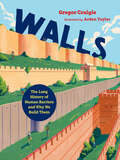
Walls: The long history of human barriers and why we build them (Orca Timeline #5)
By Gregor Craigie. 2024
Building walls that separate us from others is as old as humanity. People have built walls to keep others out…
for thousands of years, from the Great Wall of China to Hadrian's Wall to security fences along the US-Mexico border. But did you know they've also been built to keep people in, to grow food, to control nature and to collect taxes? Sometimes they've helped people and kept communities safe, but they've also created inequity and done more harm than good. Why do we have walls at all? Walls: the Long History of Human Barriers and Why We Build Them explores the many reasons humanity has put up walls over the course of our history, and why we continue building them today
Vote for our future!
By Margaret McNamara. 2020
The students of Stanton Elementary School, which is a polling place, find out all they can about voting and then…
encourage everyone in their neighborhoods to cast their ballots. PRINT/BRAILLE. For grades K-3. 2020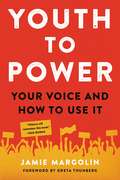
Youth to power: your voice and how to use it
By Jamie Margolin. 2020
Young climate justice activist and co-executive director of Zero Hour provides advice on organizing successful events and peaceful protests, time…
management as a student activist, utilizing social media and traditional media to spread a message, writing and pitching op-eds, and sustaining long-term action. For senior high and older readers. 2020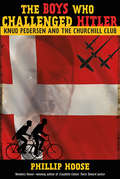
The boys who challenged Hitler: Knud Pedersen and the Churchill Club
By Phillip M Hoose. 2015
"At the outset of World War II, Denmark did not resist German occupation. Deeply ashamed of his nation's leaders, fifteen-year-old…
Knud Pedersen resolved with his brother and a handful of schoolmates to take action against the Nazis if the adults would not. Naming their secret club after the fiery British leader, the young patriots in the Churchill Club committed countless acts of sabotage, infuriating the Germans, who eventually had the boys tracked down and arrested. But their efforts were not in vain: the boys' exploits and eventual imprisonment helped spark a full-blown Danish resistance. Interweaving his own narrative with the recollections of Knud himself, here is Phil Hoose's inspiring story of these young war heroes"-- Provided by publisher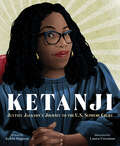
Ketanji: Justice Jackson's journey to the U.S. Supreme Court
By Kekla Magoon. 2023
"Ketanji Brown Jackson is no stranger to overcoming obstacles. When a high school guidance counselor told her she should set…
her sights lower than Harvard, she decided to go to Harvard for college and law school. When she became a public defender and saw inequalities in the justice system, she used her legal skills to advocate for people who needed help, but couldn't afford an attorney. Ketanji's path to the Supreme Court was unique: She's the only current Justice to have been a public defender and one of a few who went to public school. Her story is powerful and heartening, and it's a lesson in overcoming adversity by being true to yourself"-- Provided by publisher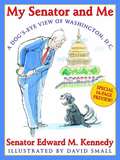
My senator and me: a dog's eye view of Washington, D.C
By Edward M Kennedy. 2006
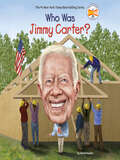
Who was jimmy carter? (Who Was?)
By David Stabler. 2022
How did a peanut farmer from a small town in Georgia become the 39th President of the United States? Find…
out in this addition to the #1 New York Times best-selling Who Was? series! Everyone was rather surprised when small-town farmer Jimmy Carter first announced that he’d be running for president in 1976. When Jimmy told his mother, she replied, “President of what?” But this former naval officer and governor of Georgia was ready for the role. Jimmy Carter went on to become one of America’s most beloved political figures thanks to his honesty, strong faith, and compassion. Today, Jimmy Carter is remembered for his dedication to helping Americans through his extensive work as a philanthropist. He and his wife, Rosalynn, volunteered with Habitat for Humanity, building houses for the less fortunate and inspiring others to a life of service. Who Was Jimmy Carter? details the entire life of Jimmy Carter, beginning with his 1924 birth in Plains, Georgia. Readers will learn about his life as a peanut farmer, a Sunday school teacher, a president, a Nobel Prize winner, and more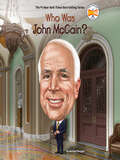
Who was john mccain? (Who Was?)
By Michael Burgan. 2023
How did the son of a naval officer go on to become a United States Navy captain, an Arizona senator,…
and a candidate for president? Find out in this addition to the #1 New York Times best-selling Who Was? series! In 2008, John McCain ran for president against Barack Obama, becoming a well-known national figure. But his presidential campaign was only one of the many inspirational things John accomplished in his lifetime! John was a decorated member of the US Navy who survived being a prisoner of war in Vietnam. He served as an Arizona senator for thirty years, right up until his passing in 2018. Learn all about John McCain and his life as politician who always tried to work across the aisle and to treat people fairly in this book about the maverick patriot.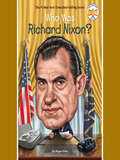
Who was richard nixon? (Who Was?)
By Megan Stine. 2020
Learn more about Richard Nixon—one of America's most unpopular presidents and the only one to resign from the position .…
On August 8, 1974, millions sat stunned as they watched Richard Nixon on TV when he announced he was stepping down as the President of the United States. He'd participated in a scandal that included secret tape recordings, a burglary, and a cover-up, and now his secrets and lies were catching up to him. How could Nixon, a man who had been reelected in a landslide victory just two years earlier, now be leaving office in disgrace? Author Megan Stine takes readers through President Nixon's life—from his childhood and military experiences during World War II—to his long political career and the Watergate scandal that tarnished his legacy and deepened American's mistrust of the government
The thing you're good at
By Lesley Choyce. 2020
Jake's friend Maria is the daughter of undocumented immigrants who have been living and working in the country for a…
long time. But the new government has implemented a crackdown. Maria's parents are detained and quickly sent out of the country. Maria, who was born here, decides to hide out in Jake's basement rather than risk becoming a ward of the state. But when she returns to her old apartment to retrieve her hidden birth certificate, Maria is abducted by young men on the lookout for teenage girls who have lost their parents to deportation. Jake is determined to rescue Maria before she's turned over to the authorities. Or worse. For junior and senior high readers. Unrated
Larger than life: Lyndon B. Johnson and the right to vote
By Anne Quirk. 2021
Keenly known for both his triumphs and his failures, Lyndon B. Johnson was one of the most complex and compelling…
presidents in US history. With engaging storytelling, Quirk paints a rich portrait of Johnson's presidency, celebrating the accomplishments of his Great Society programs while refusing to shy away from his catastrophic decisions regarding Vietnam and the summer riots of 1967. Larger Than Life presents striking parallels to today's political arena: an outsize character presiding over a divided nation but to different ends. For grades 5-8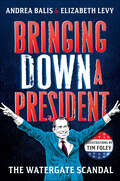
Bringing Down a President: The Watergate Scandal
By Andrea Balis, Elizabeth Levy. 2019
A middle-grade retelling of Richard Nixon's downfall, Bringing Down A President: The Watergate Scandal is an inventive and timely look…
at one of the biggest scandals to ever rock our nation by Andrea Balis and Elizabeth Levy, featuring graphic novel style illustrations by Tim Foley.Comprised almost completely of primary source quotes (good thing Nixon's recorder was on) and interspersed with contextual narrative, this captivating account of the trials and tribulations of the Nixon Administration has been rendered screenplay style offering an extraordinarily immediate narrative of one of America's most turbulent eras.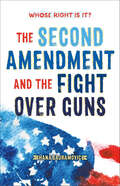
Whose Right Is It? The Second Amendment and the Fight Over Guns
By Hana Bajramovic. 2020
Discover the truth about the Second Amendment, the NRA, and the United States’ centuries-long fight over guns in this first-of-its-kind…
book for middle grade readers."A compelling, clear analysis of one of our country’s oldest dilemmas: how to balance gun rights with public safety. It tells the full and true story of the Second Amendment, and points to a way to bring sanity to our gun laws. A remarkable primer for all ages." —Michael Waldman, author of The Second Amendment: A Biography For the majority of the United States’ history, the right to own a gun belonged to a “well regulated militia.” That changed in 2008 with the historic District of Columbia v. Heller case, which ruled that the Second Amendment protected an individual’s right. In the years since, the debate over gun legislation has reached a crescendo. And the issue grows ever relevant to children across America, with an estimated three million exposed to shootings every year. From metal detectors to see-through backpacks to shooting drills, kids face daily reminders of the threat of guns. Hana Bajramovic's Whose Right Is It? The Second Amendment and the Fight Over Guns reveals how a once obscure amendment became the focus of daily heated debate. Filled with historical photos and informative graphics, the book will show young readers how gun legislation has always been a part of American history and how money, power, and systemic racism have long dictated our ability to own guns.A Junior Library Guild Selection"Hana Bajramovic provides readers with a compelling overview on the history of guns in the United States and the changing, conflicting interpretations of the Second Amendment certain to stimulate conversation and thinking on the part of future generations." —Award-winning author Doreen Rappaport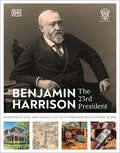
Benjamin Harrison: The 23rd President
By Dk. 2025
Tour through Benjamin Harrison’s house and discover the life and legacy of the 23rd US PresidentTake a trip to Indianapolis…
and peek into a president’s parlor for a house tour like no other.After introducing the neighborhood, we will guide you around the historic home of the 23rd President of the US and look at some of the 10,000 objects on display – each one revealing a story about the man and his family.From being a Civil War general who led from the front with a cry of “Come on, boys!” to chasing his grandchildren’s pet goat down the road outside the White House, there is much to learn about Benjamin Harrison.See how Harrison’s Front Porch Campaign was conducted – before there was a porch!Find out how he championed African-American rights and was ahead of his time with conservation policies.Learn about his involvement with the longest US jury trial of the 19th century.Discover what a rattle, a ribbon, and an axe have in common.*Harrison was first and foremost a family man. This tour takes you into the private quarters, including bedrooms and sitting rooms. You can check out wife Caroline’s art, her plans for the White House, and her involvement with the DAR (Daughters of the American Revolution). Admire daughter Mary’s ostrich-feather cape, which she wore when presented to English royalty, and see daughter Elizabeth grow from the cute, curly-haired little girl to a glamourous 1920s woman. From family photos right down to the burn-mark from an iron on the pantry shelves, this book gets inside the family home and reveals all.The tour finishes with the Benjamin Harrison Presidential Site today – the research library, the promenade and grounds – and leaves you with a real sense of the Harrison legacy. Complete with a biography, timeline, and quotations, this book is a fascinating introduction to the man and his mansion.*For the answer, see pages 26–27!
The CIA World Factbook 2025-2026
By Central Intelligence Agency. 2025
The ultimate, comprehensive guide to official country data and statistics, from the world&’s most sophisticated intelligence-gathering organization. From Afghanistan to…
Zimbabwe, The CIA World Factbook 2025-2026 offers complete and up-to-date information on the world's nations. This comprehensive guide is packed with data on countries' politics, populations, economics, and environment for 2025 and looks ahead to 2026. The CIA World Factbook 2025-2026 includes the following for each country: Updated geopolitical maps Population statistics, with details on languages, religions, literacy rates, age structure, health indicators, and much more Up-to-date data on military expenditures and capabilities Geography information, including climate and natural hazards Details on prominent political figures and parties Contact information for diplomatic missions Facts on transportation, trade, and communication infrastructure Space program profiles for over 90 participating nations Also included are appendices with useful abbreviations, terror organization profiles, and more. Originally intended for use by government officials and policymakers as well as the broader intelligence community, this is a must-have resource for students, travelers, journalists, and anyone with a desire to know more about their world.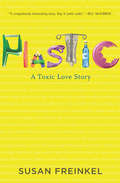
Plastic: A Toxic Love Story
By Susan Freinkel. 2011
Plastic built the modern world. Where would we be without bike helmets, baggies, toothbrushes, and pacemakers? But a century into…
our love affair with plastic, we’re starting to realize it’s not such a healthy relationship. Plastics draw on dwindling fossil fuels, leach harmful chemicals, litter landscapes, and destroy marine life. As journalist Susan Freinkel points out in this engaging and eye-opening book, we’re nearing a crisis point. We’ve produced as much plastic in the past decade as we did in the entire twentieth century. We’re drowning in the stuff, and we need to start making some hard choices. Freinkel gives us the tools we need with a blend of lively anecdotes and analysis. She combs through scientific studies and economic data, reporting from China and across the United States to assess the real impact of plastic on our lives. She tells her story through eight familiar plastic objects: comb, chair, Frisbee, IV bag, disposable lighter, grocery bag, soda bottle, and credit card. Her conclusion: we cannot stay on our plastic-paved path. And we don’t have to. Plastic points the way toward a new creative partnership with the material we love to hate but can’t seem to live without.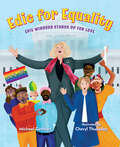
Edie for Equality: Edie Windsor Stands Up for Love
By Michael Genhart. 2025
This is a story about a great injustice and how Edie Windsor boldly stood up for what was right and…
went up against the highest court in the United States.Growing up in the 1930s, Edie Windsor hadn't always been bold. In fact, she was someone who played by the rules and loved math. Numbers added up right every time and equal meant equal. But when the US government refused to acknowledge the loving relationship of over forty years between her and her spouse Thea Spyer, Edie made a bold move and sued the US government! In this comprehensive picture book biography, acclaimed author Michael Genhart shares the story of LGBTQ icon Edie Windsor and the pivotal case that set the stage to take down the Defense of Marriage Act (DOMA). In United States v. Windsor, Edie's tenacious spirit proved to the Supreme Court and the world that love is love and equal means equal.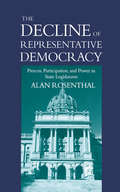
The Decline of Representative Democracy: Process, Participation, and Power in State Legislatures
By Alan Rosenthal. 1996
Based on a leading scholar′s firsthand observations of legislatures as well as extensive interviews with legislators, legislative staff, and lobbyists,…
this important work describes and analyzes the contemporary state of legislatures and the legislative process in the fifty states. It explores the principal elements of legislatures, including the processes by which legislation is enacted, the impact of the media, political competition and partisanship, lobbyists and lobbying, the challenge of ethics, the role of leadership, and the linkage between legislators and their constituencies.Thematically, Alan Rosenthal argues that despite the popular perception that legislatures are autocratic, arbitrary, isolated, unresponsive, and up for sale, legislatures are, in fact, extraordinarily democratic and becoming more so. He concludes, furthermore, that the dangers to representative democracy today are substantial. The Decline of Representative Democracy builds on the growing literature in state politics and state legislatures. It also relies on the author′s participant-observer research, interviews conducted especially for this book, and his years in the field. Many illustrative examples help to clarify the theoretical points made throughout the book, which in turn provide provocative sources of debate for students of the legislative process.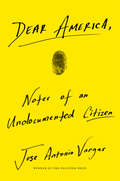
Dear America: Notes of an Undocumented Citizen
By Jose Antonio Vargas. 2018
THE NATIONAL BESTSELLER“This riveting, courageous memoir ought to be mandatory reading for every American.” —Michelle Alexander, New York Times bestselling author…
of The New Jim Crow“l cried reading this book, realizing more fully what my parents endured.” —Amy Tan, New York Times bestselling author of The Joy Luck Club and Where the Past Begins“This book couldn’t be more timely and more necessary.” —Dave Eggers, New York Times bestselling author of What Is the What and The Monk of MokhaPulitzer-Prize winning journalist Jose Antonio Vargas, called “the most famous undocumented immigrant in America,” tackles one of the defining issues of our time in this explosive and deeply personal call to arms.“This is not a book about the politics of immigration. This book––at its core––is not about immigration at all. This book is about homelessness, not in a traditional sense, but in the unsettled, unmoored psychological state that undocumented immigrants like myself find ourselves in. This book is about lying and being forced to lie to get by; about passing as an American and as a contributing citizen; about families, keeping them together, and having to make new ones when you can’t. This book is about constantly hiding from the government and, in the process, hiding from ourselves. This book is about what it means to not have a home.After 25 years of living illegally in a country that does not consider me one of its own, this book is the closest thing I have to freedom.”—Jose Antonio Vargas, from Dear America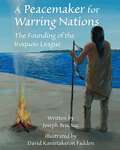
A Peacemaker for Warring Nations: The Founding of the Iroquois League
By Joseph Bruchac. 2021
The League of the Iroquois was a true representational democracy—so much so that the United States Constitution is said to…
have been modeled on some of its tenets. But how, perhaps a thousand years before the time of Columbus, did the Five Iroquois Nations (the Mohawk, Onondaga, Oneida, Cayuga, and Seneca) come to end the bitter eye-for-eye warfare among them? What brought them together in an alliance based on the Great Law of Peace? And how was it that a system of Clan Mothers was instituted in which women are seen as the center of the nation and still today choose the 50 royaners, or peace chiefs, who speak for their respective communities in meetings of the League? In A Peacemaker for Warring Nations, renowned Native author Joseph Bruchac draws from the teachings of both contemporary and past Iroquois tradition bearersin telling the inspiring story of how &“the Peacemaker,&” a divine messenger sent by the Creator, helped to bring reconciliation to warring nations. The book is beautifully and accurately illustrated by David Kanietakeron Fadden, a respected Mohawk artist whose work honors his deep indigenous roots.